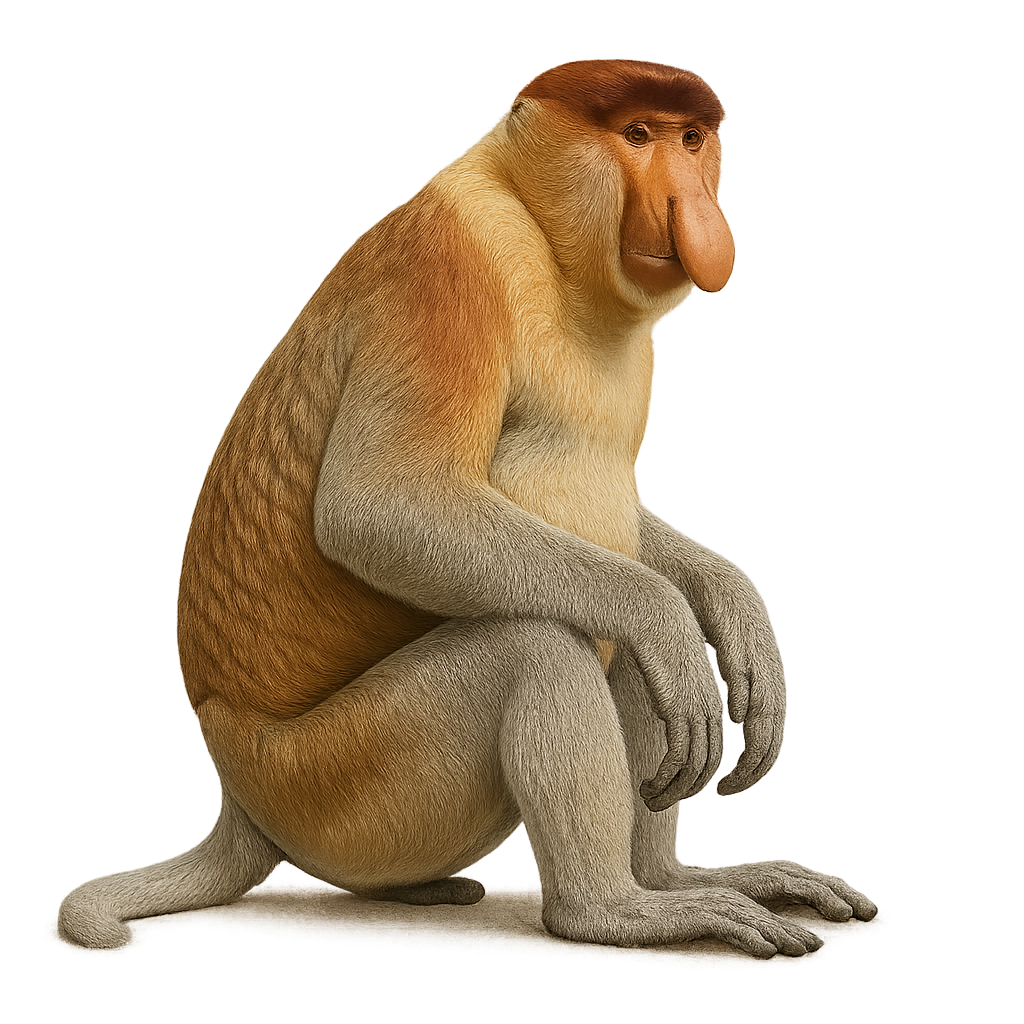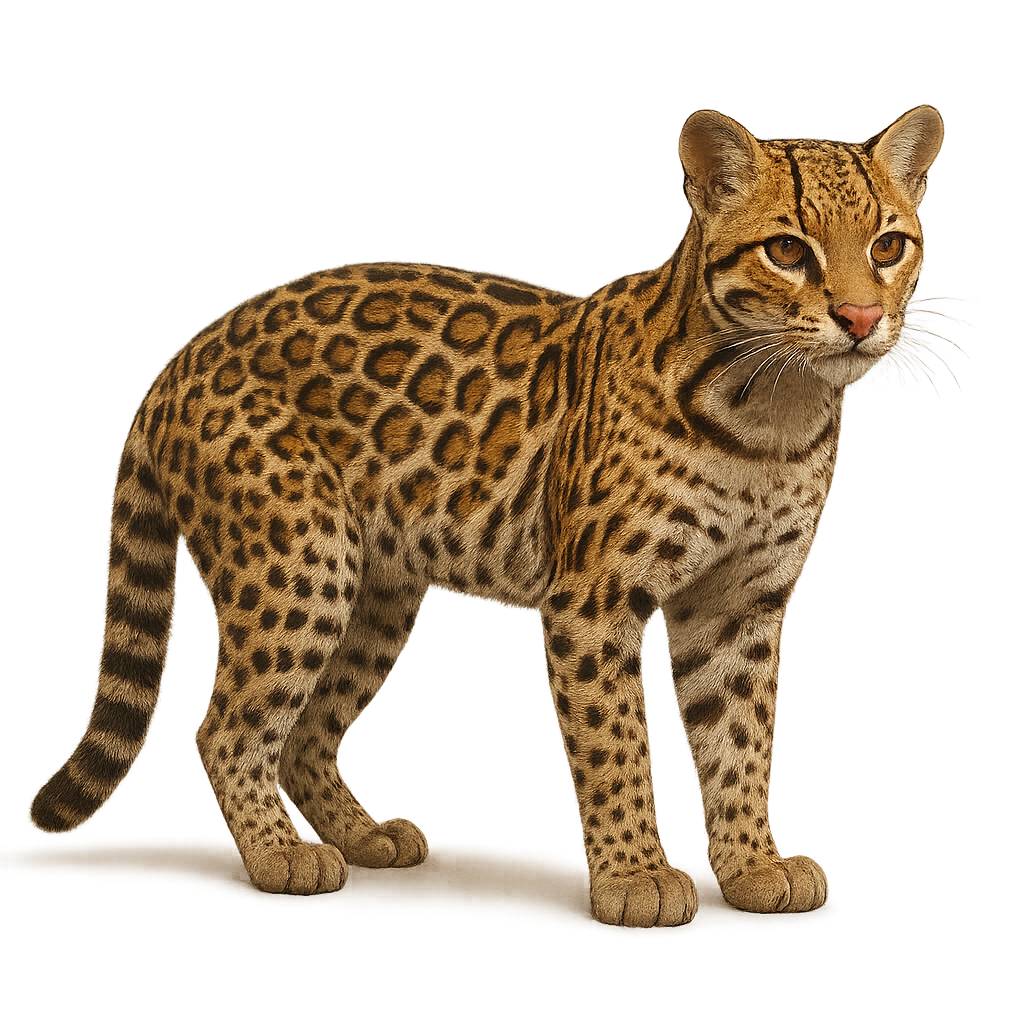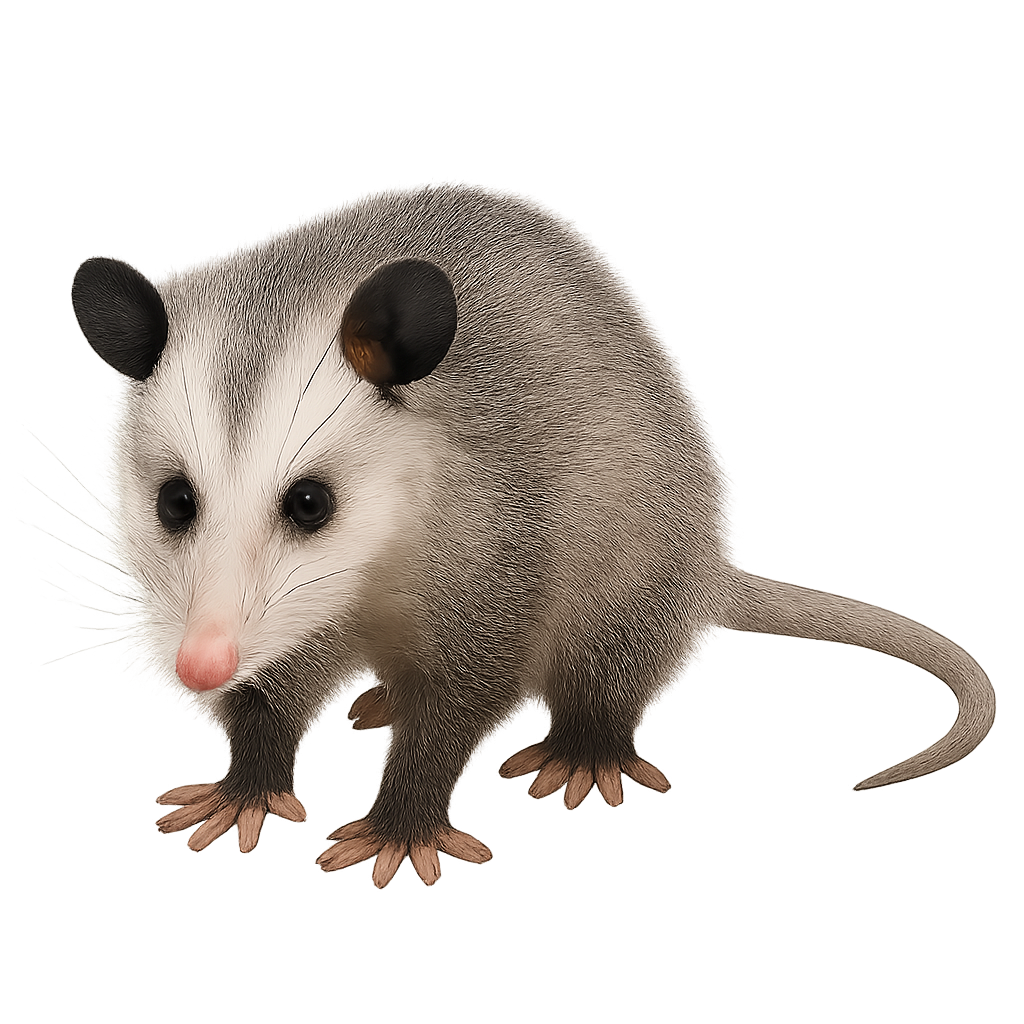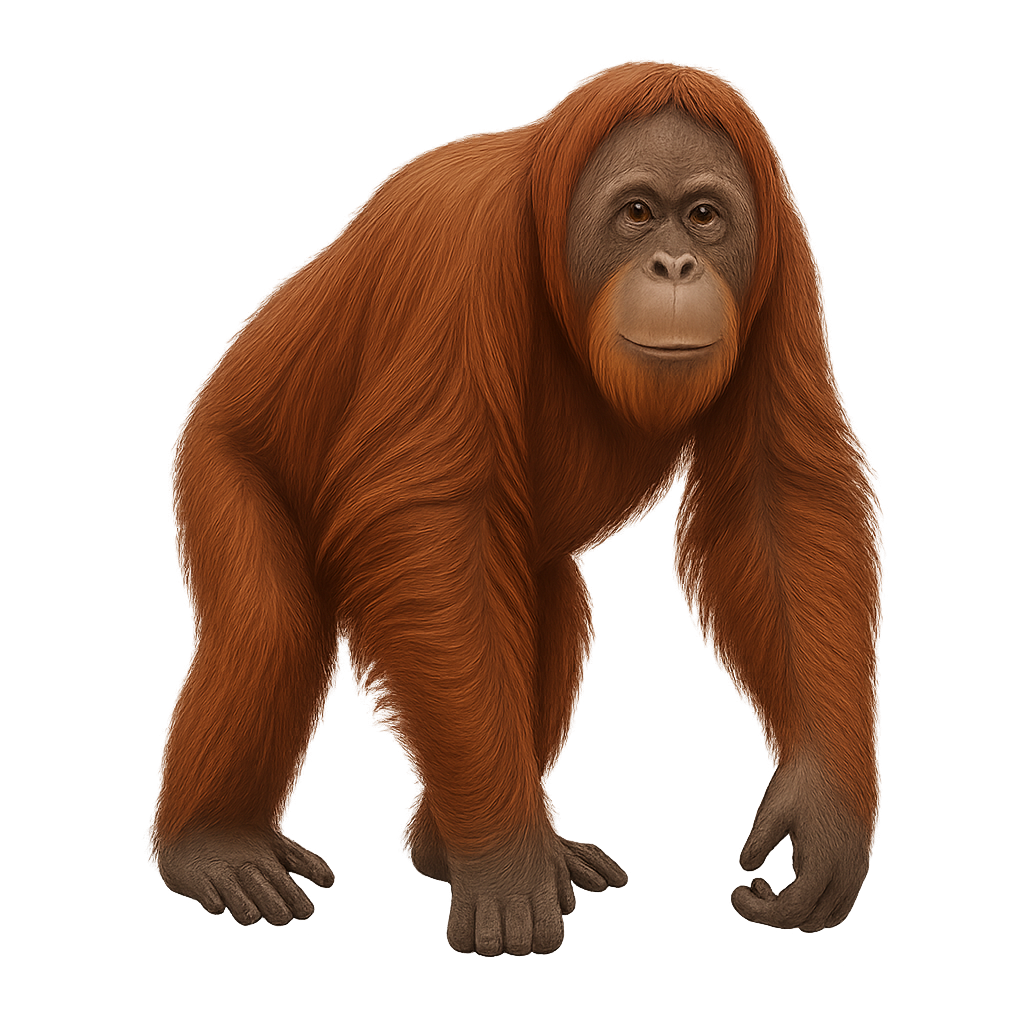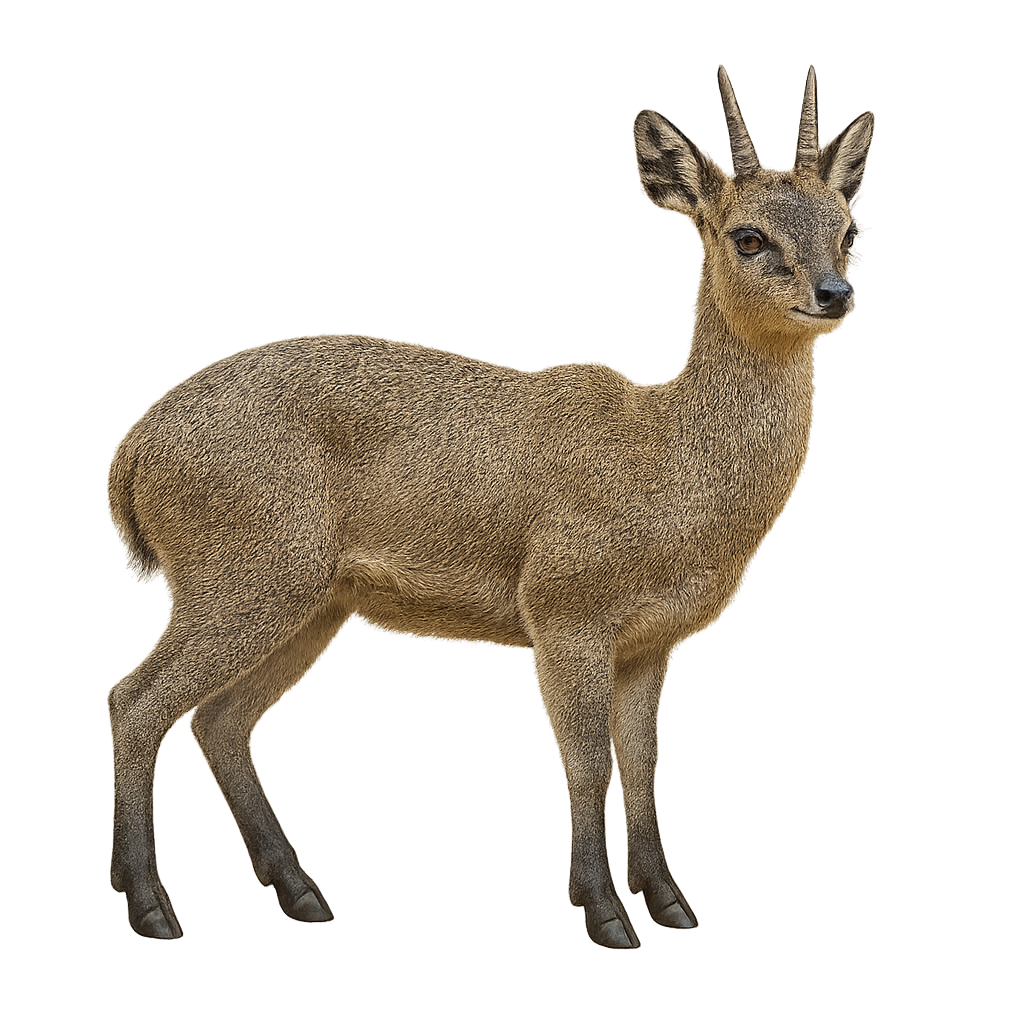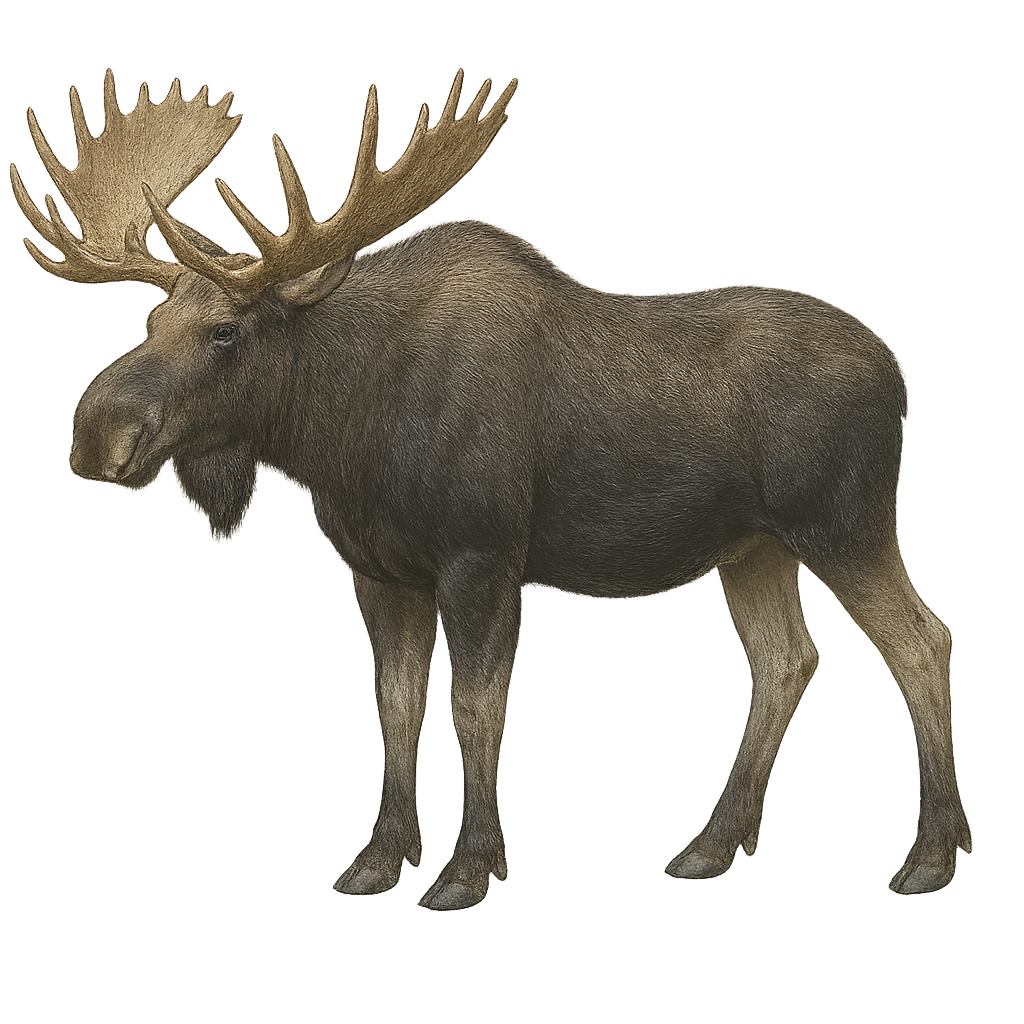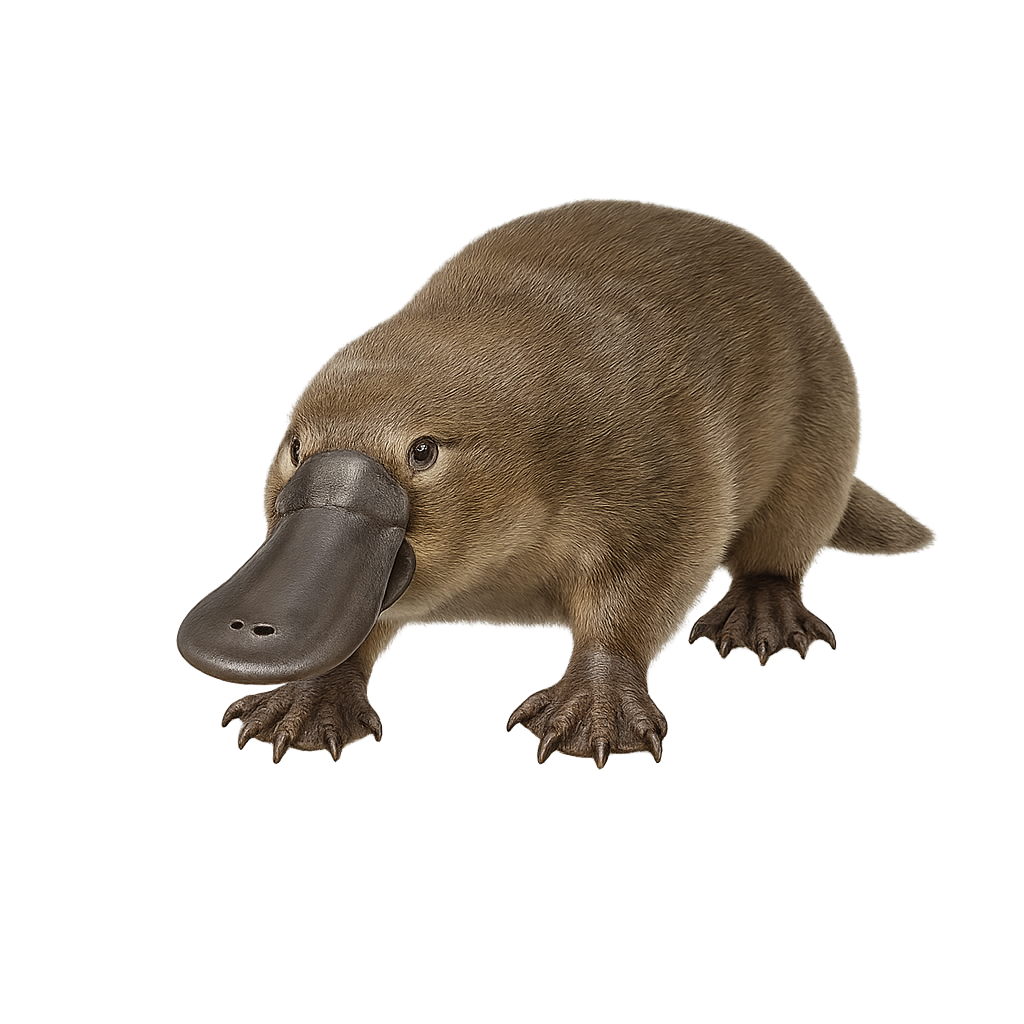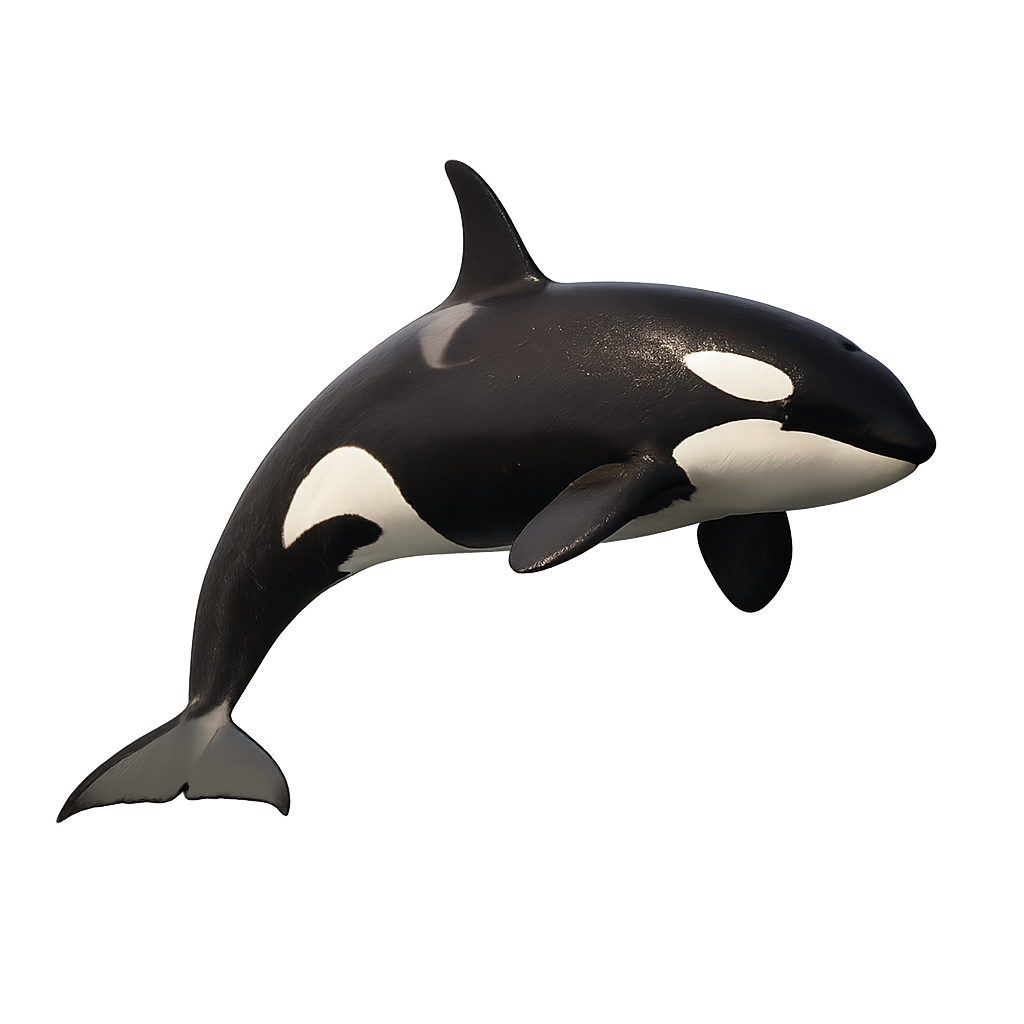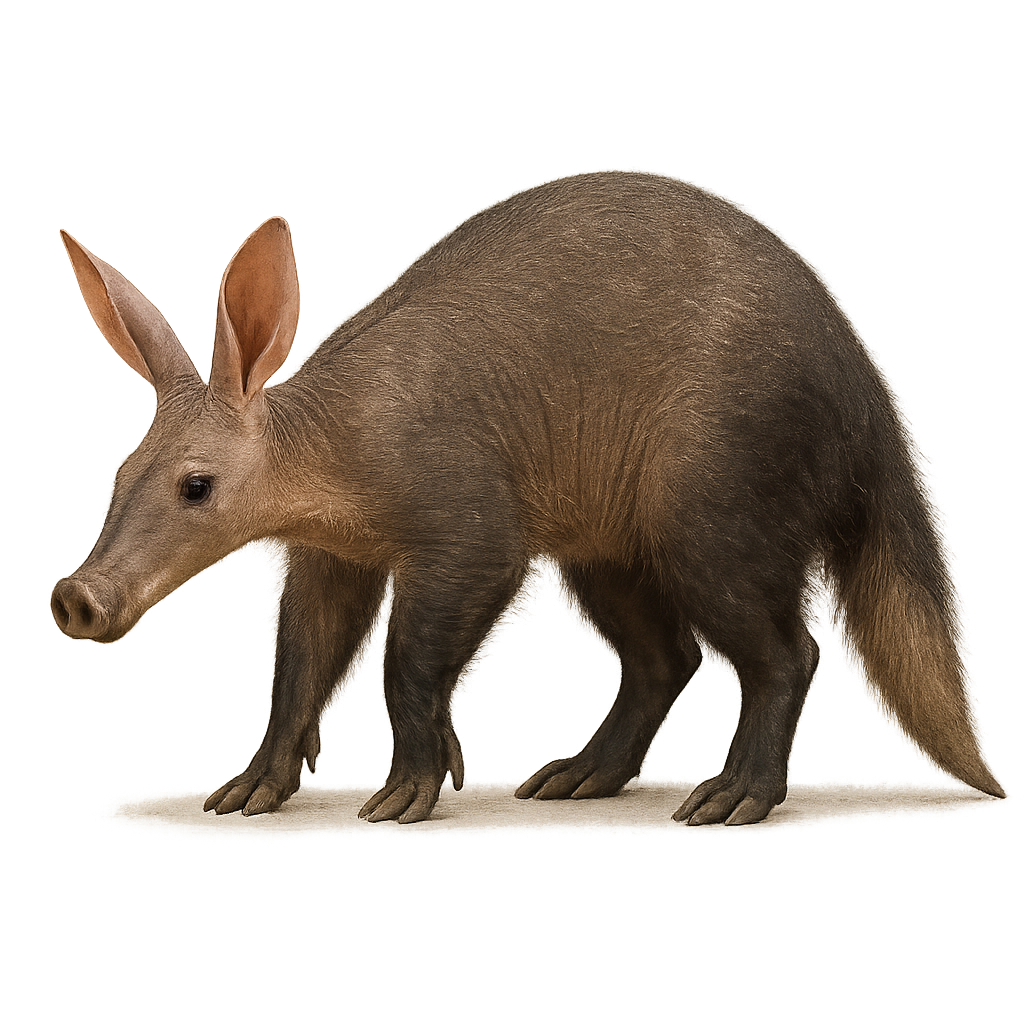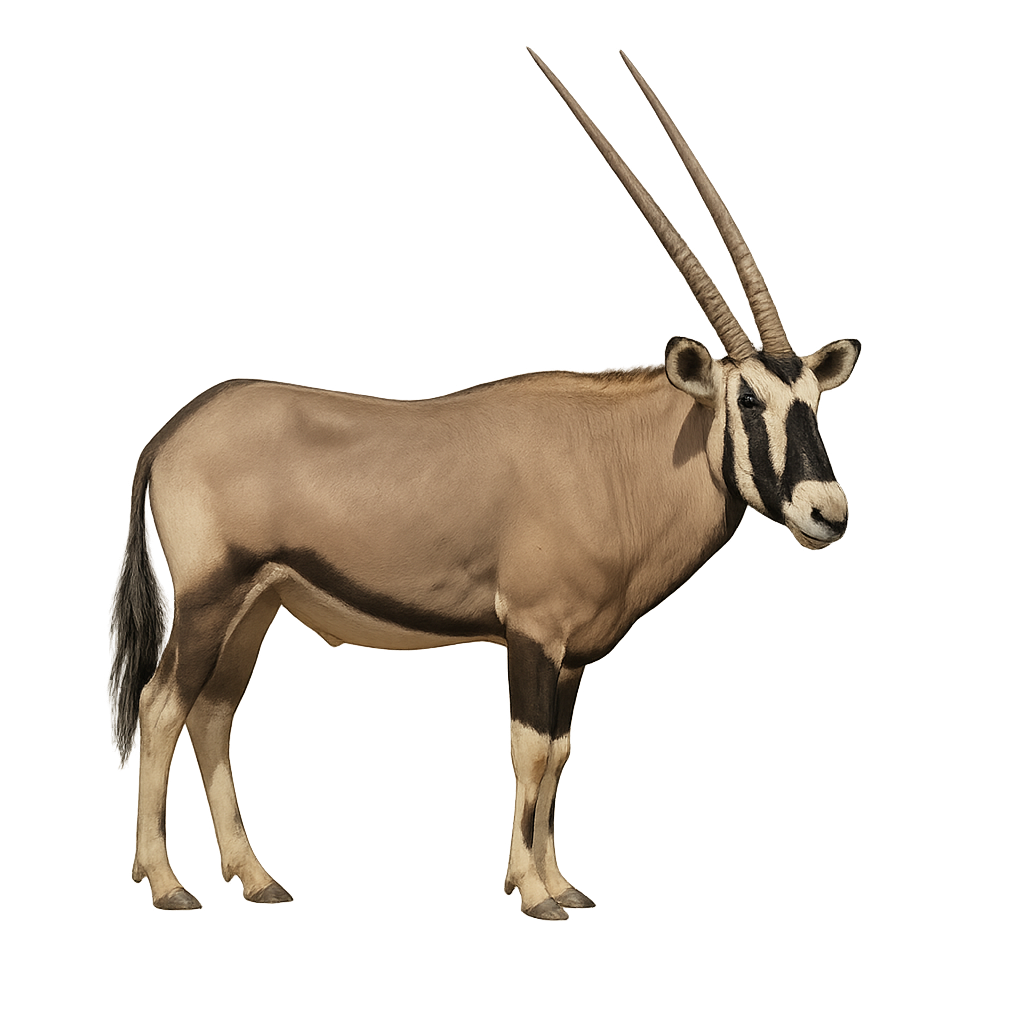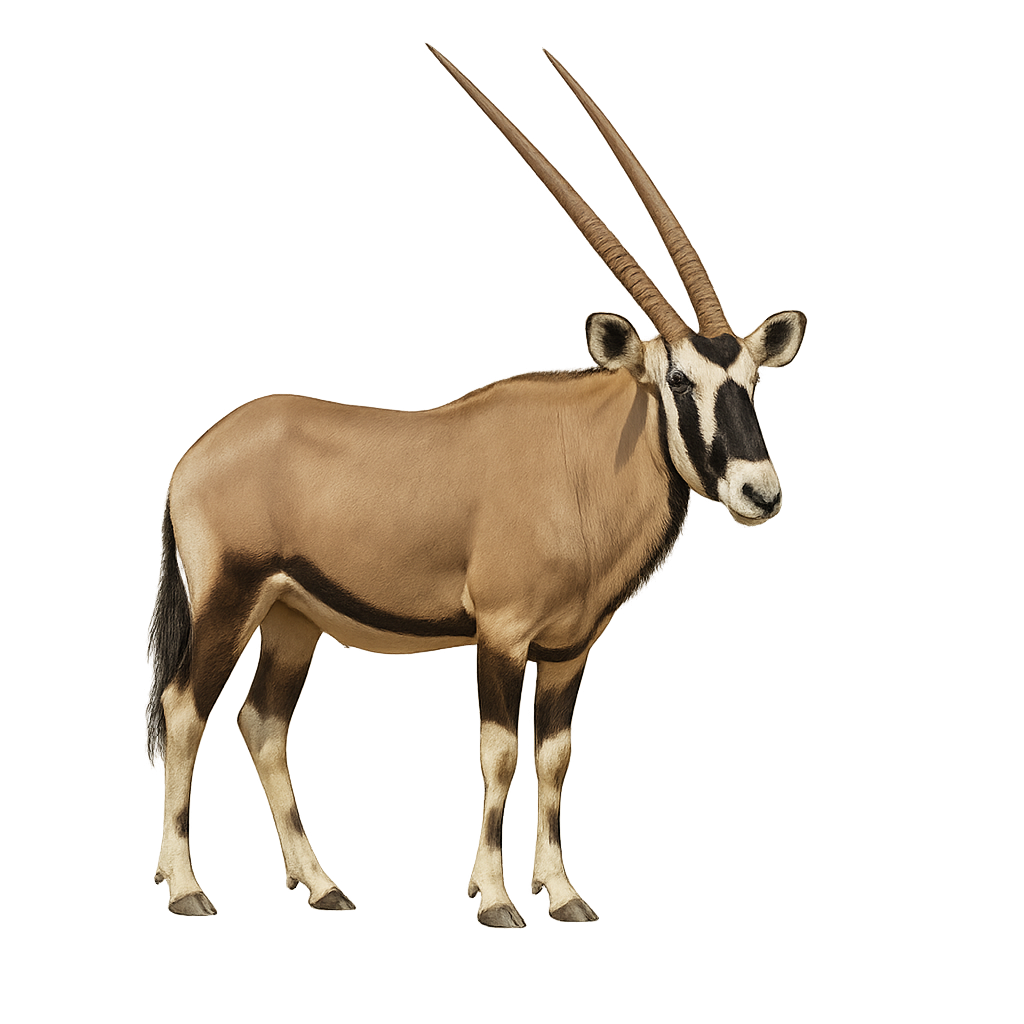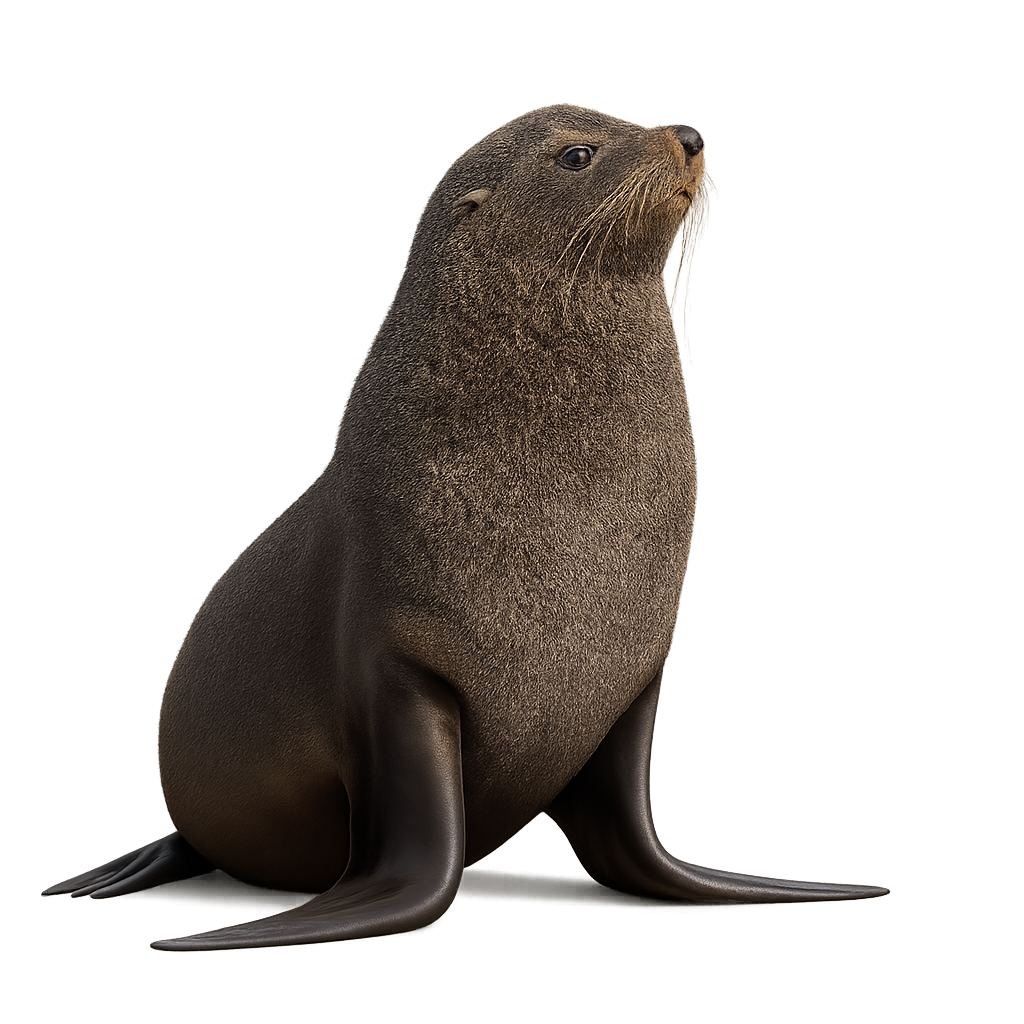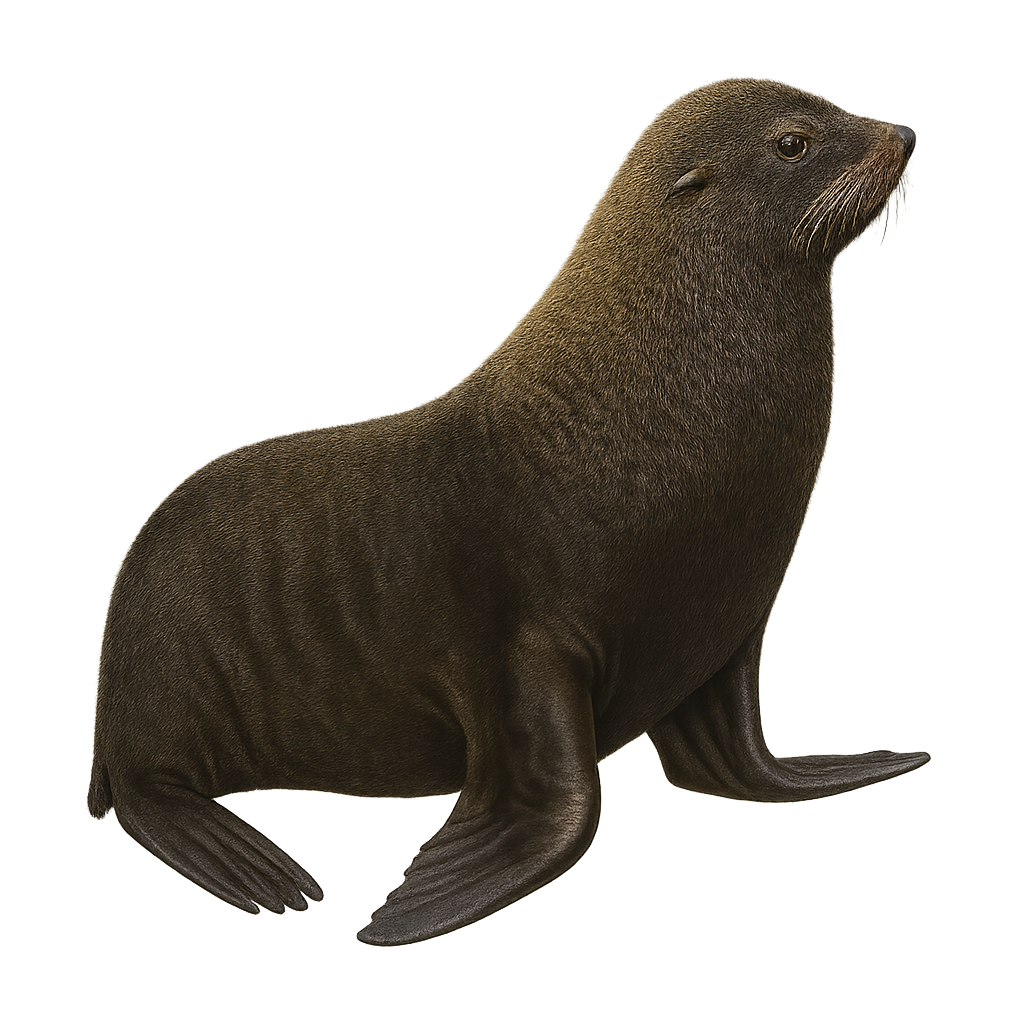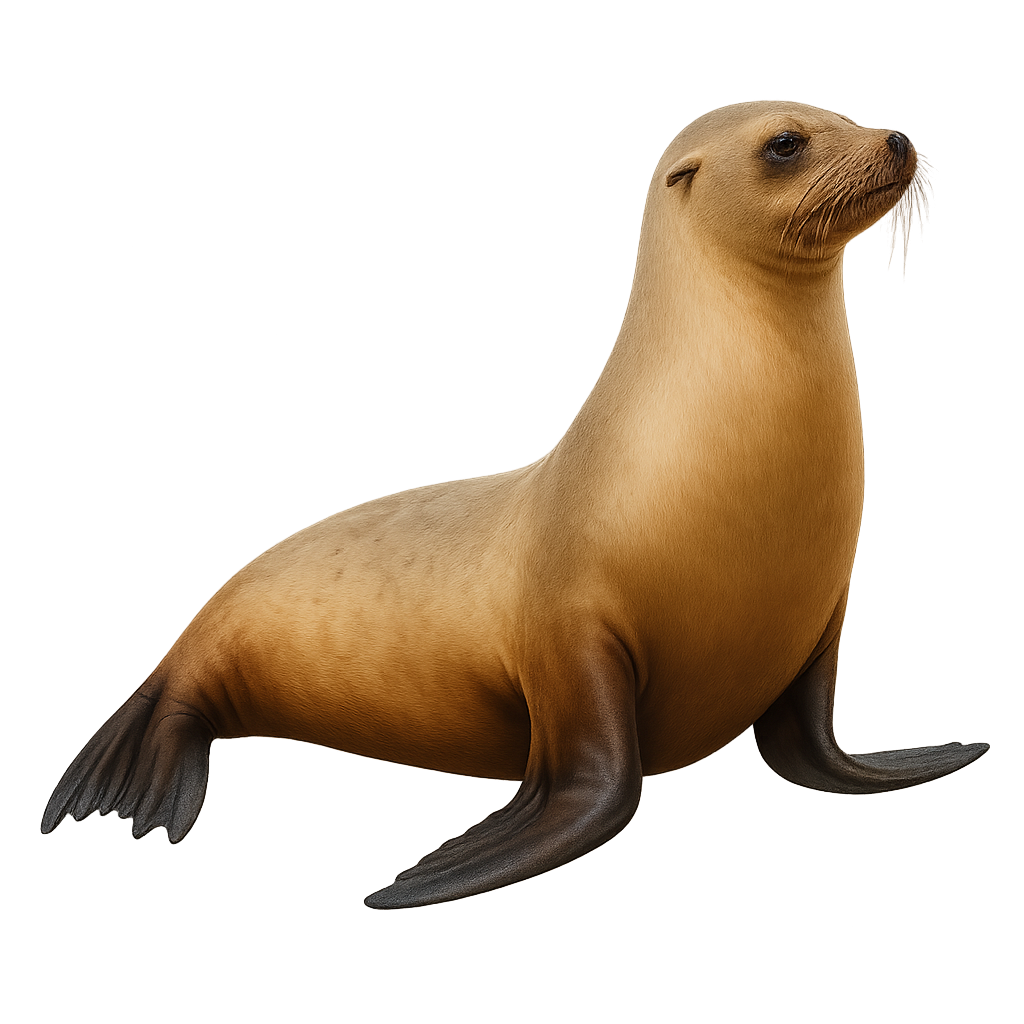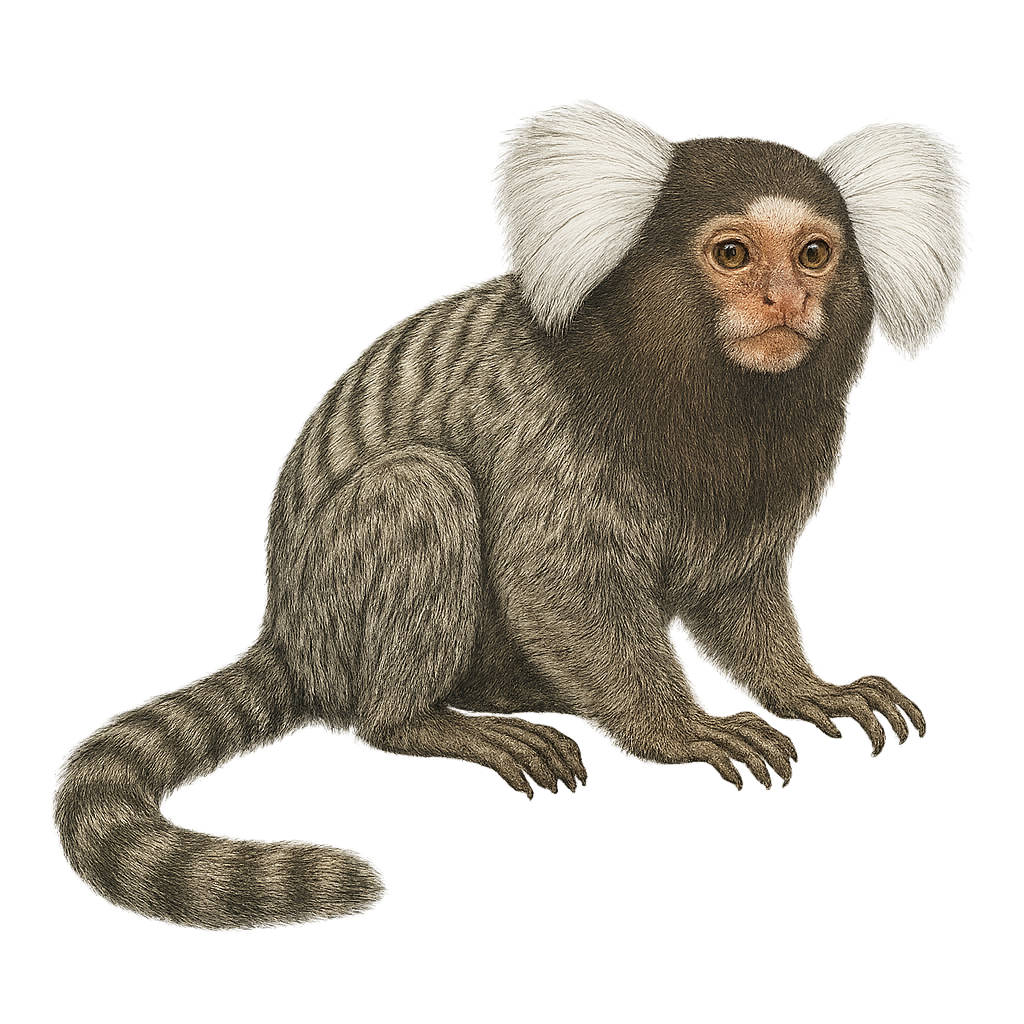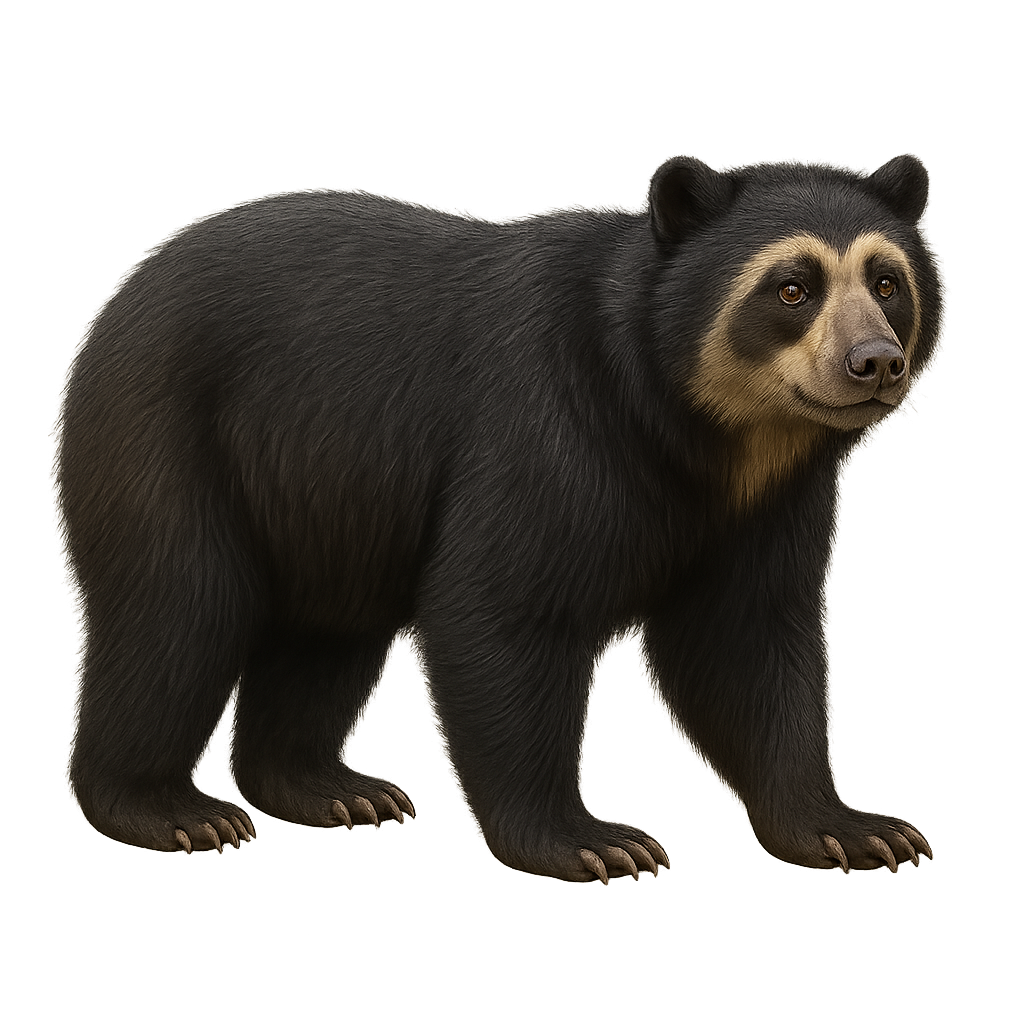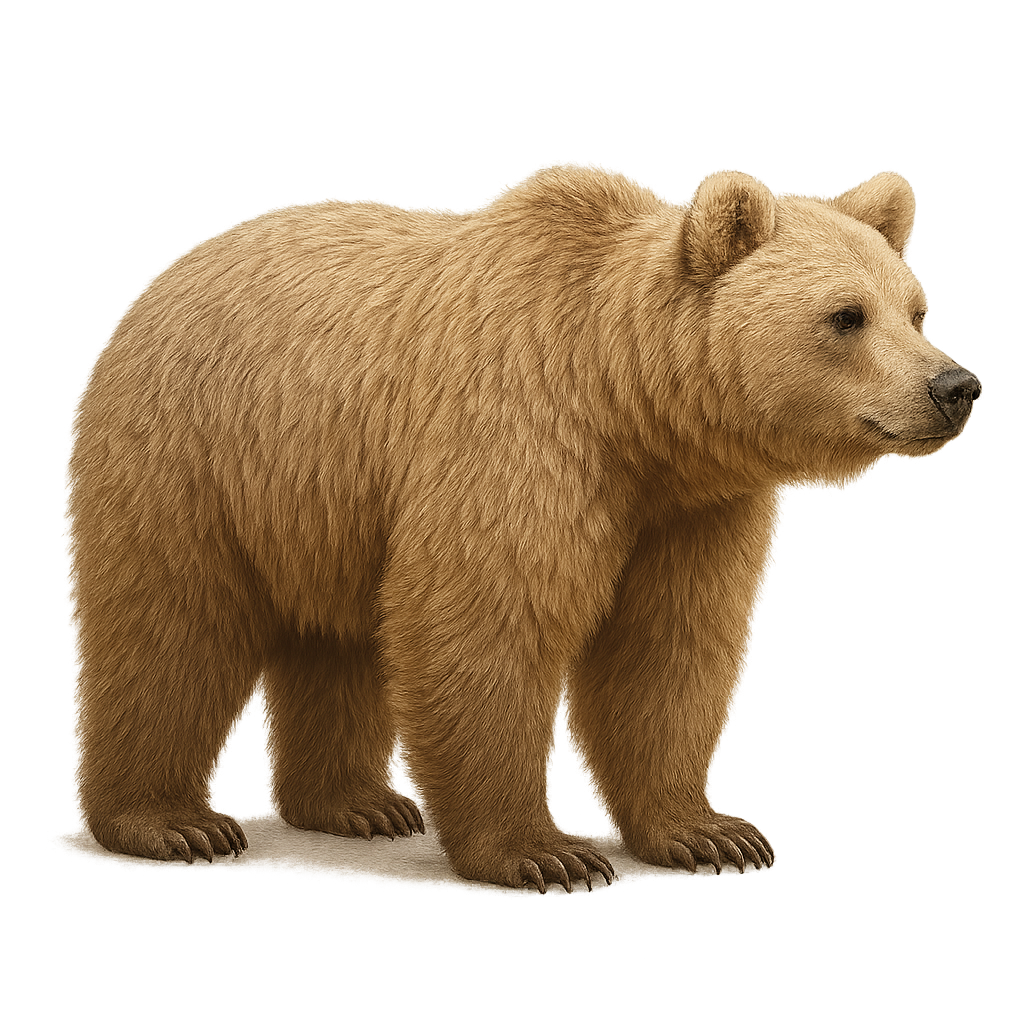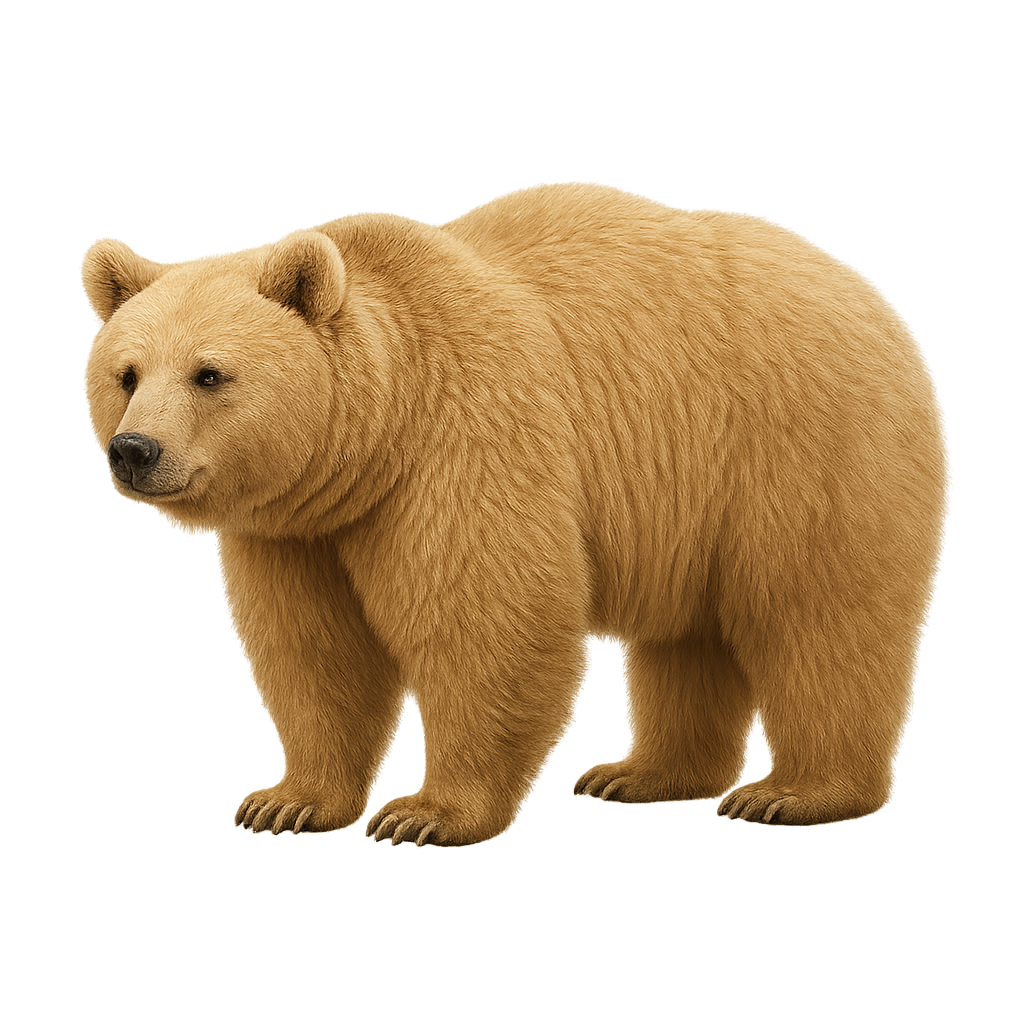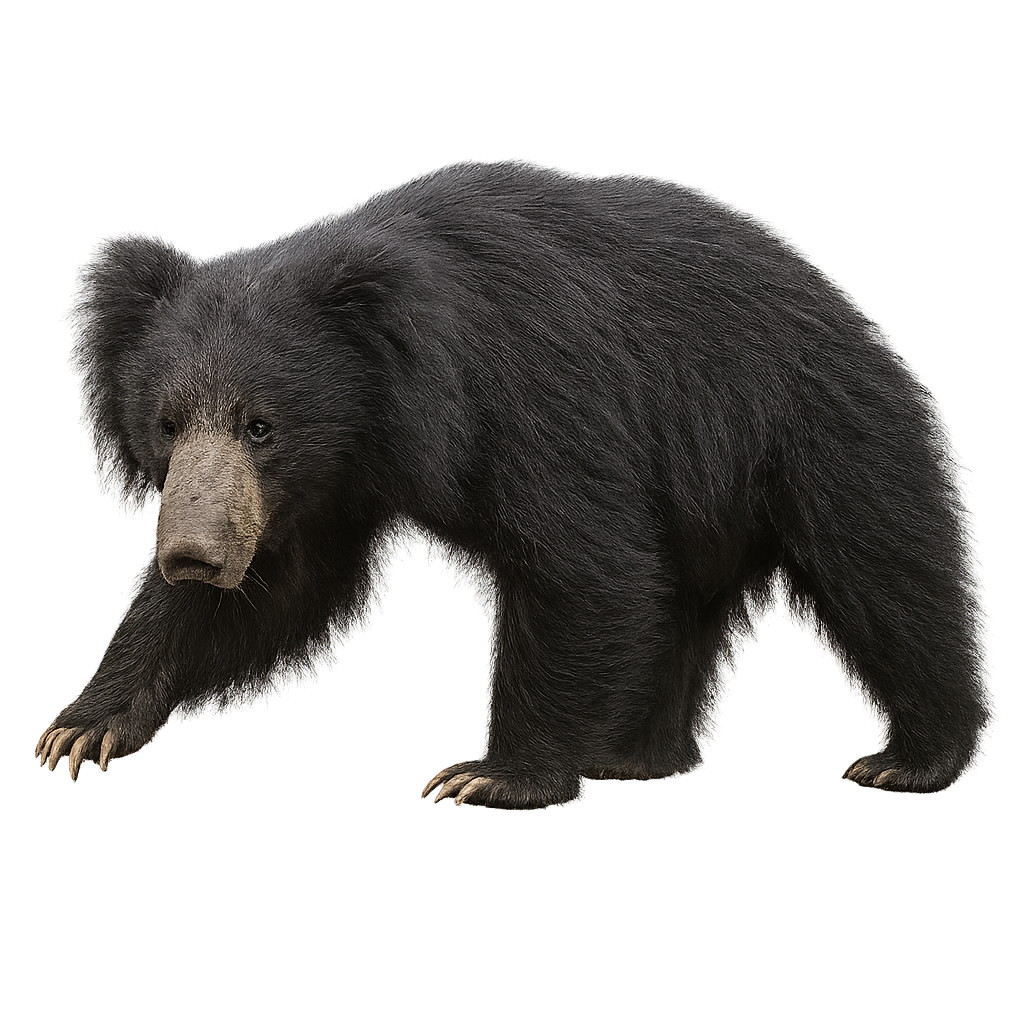The Narwhal is a unique cetacean, often referred to as the "unicorn of the seas" due to the long twisted tusk it possesses, typically in males. It measures between 4 and 5 meters in length and can weigh up to 1,600 kg. The narwhal's tusk can reach up to 3 meters in length and is actually a tooth that grows asymmetrically, often spiraling. Its body is gray to white with black and white patches that vary from one individual to another. The Narwhal primarily inhabits the cold waters of the Arctic, where it feeds on fish, crustaceans, and cephalopods. It is an excellent diver, capable of descending to great depths in search of food. While its population remains relatively stable, it is threatened by climate change, water pollution, and human disturbances. Due to its beauty and rarity, it is also highly sought after for illegal horn trade.
The Proboscis Monkey is a large primate native to the tropical forests of Borneo and Sumatra. It measures about 60 to 75 cm in length and weighs between 15 and 25 kg. It is easily recognizable by its prominent, elongated nose, which can measure up to 10 cm in adult males. This nose is particularly developed in males and plays a role in vocalizations and attracting females. Its coat is generally brown or reddish, with a lighter belly. The Proboscis Monkey primarily inhabits mangroves, lowland forests, and mountain forests, where it feeds mainly on leaves, fruits, seeds, and roots. It is an excellent climber and spends much of its time in the trees, typically living in social groups consisting of several females and their young. While its population remains relatively stable, it faces threats such as deforestation, hunting, and habitat loss.
The numbat is a small insectivorous marsupial endemic to Western Australia, measuring 25–35 cm long with a reddish coat marked by horizontal white bands. Strictly diurnal, it feeds almost exclusively on termites, which it captures using its long sticky tongue and powerful front claws. Solitary, it occupies abandoned burrows or natural hollows in dry eucalyptus woodlands and pine forests. During the breeding season, males and females become more territorial and engage in rapid ground chases before mating.
The Ocelot is a medium-sized wild cat, measuring between 55 and 100 cm in length (excluding the tail) and weighing between 8 and 16 kg. It is distinguished by its spotted and striped coat, which helps it blend effectively into dense forests and wooded areas where it lives. Its fur is generally golden or grayish, with black marks in the form of spots or rosettes across the body. The Ocelot is a nocturnal and solitary hunter, primarily feeding on small mammals, birds, reptiles, and fish. It is agile and fast, capable of climbing trees to hunt or escape predators. This cat is primarily found in Central and South America, in tropical forests, savannas, and mountainous areas. While its population remains stable in some regions, the Ocelot is threatened by deforestation, illegal hunting, and habitat loss.
The Okapi is a herbivorous mammal native to the rainforests of the Democratic Republic of Congo in Central Africa. It measures between 1.5 and 2 meters in length and weighs between 200 and 350 kg, resembling a combination of a giraffe and a horse. Its coat is generally dark brown with characteristic white bands on its legs, similar to those of a zebra, hence its nickname "zebra-headed giraffe." The Okapi is a solitary and secretive animal, primarily feeding on leaves, fruits, and plant shoots. It inhabits dense forests, where it uses its sense of smell and great discretion to escape predators. While its population remains relatively stable, the Okapi is threatened by deforestation, poaching, and human conflict.
The Virginia opossum is North America’s only marsupial, 40–60 cm long (excluding tail) and weighing 2–6 kg, with grey fur and a long prehensile tail. An opportunistic omnivore, it inhabits forests, fields, and suburban areas, feeding on fruits, insects, small vertebrates, and carrion. Solitary and nocturnal, it moves slowly on the ground and climbs trees with ease.
The Bornean orangutan is a large primate, measuring about 1.2 to 1.5 meters in height and weighing between 40 and 90 kg. It is easily recognized by its reddish fur and long arms, which allow it to move effortlessly through the trees. This species is native to the island of Borneo, where it primarily inhabits tropical forests. The Bornean orangutan is an herbivore, feeding mainly on fruits, leaves, bark, and small insects. It is a solitary animal, with very discreet behaviors and a great ability to adapt to its environment. Due to deforestation, illegal hunting, and the loss of its natural habitat, this species is classified as endangered.
The Sumatran orangutan is a majestic primate, measuring between 1.2 and 1.4 meters in height and weighing between 30 and 70 kg. It has a shiny reddish fur, with long arms adapted to its arboreal lifestyle. Native to the island of Sumatra in Indonesia, this orangutan primarily inhabits tropical lowland forests and swampy areas. Its diet mainly consists of fruits, leaves, bark, and small insects. It is primarily solitary and has a great ability to camouflage among the trees. Unfortunately, this species is critically endangered due to massive deforestation, forest fires, and illegal hunting.
The Tapanuli orangutan is a recently discovered primate species, considered one of the rarest and most endangered in the world. It measures about 1.2 meters in height and weighs between 30 and 60 kg. This ape has a shiny reddish coat, with long arms adapted to its life in the trees. Native to the mountains of the Tapanuli region in northern Sumatra, Indonesia, this orangutan primarily inhabits montane tropical forests. It feeds mainly on fruits, leaves, and bark. The Tapanuli orangutan is a solitary and secretive animal and is considered critically endangered due to deforestation, mining, human conflict, and forest fires.
The klipspringer is a small African antelope known for its agility on rocky terrains. Standing about 50 cm at the shoulder and weighing between 8 and 18 kg, it has a dense, coarse coat, often brownish-grey, which helps it blend into its surroundings. Its hooves are adapted to grip rocky surfaces, allowing it to move easily across cliffs and escarpments. Klipspringers typically live in pairs or small family groups and are highly territorial. They primarily feed on leaves, fruits, and flowers and can survive without water for extended periods, deriving necessary moisture from their diet.
The Alaskan moose, or Alces alces gigas, is the largest member of the deer family. It is distinguished by its impressive size, reaching up to 2.1 meters at the shoulder and weighing over 700 kg. Its wide, flat antlers, which can span up to 2 meters, are characteristic of males. The Alaskan moose primarily inhabits the boreal forests and wetlands of Alaska and Canada. It is well adapted to cold climates thanks to its thick coat. As a herbivore, it feeds on leaves, bark, and aquatic plants. Although generally solitary, it can be seen in small groups during the rutting season.
The Platypus is a unique aquatic mammal native to Australia and Tasmania. It measures between 40 and 60 cm in length and weighs around 1 to 2.5 kg. This animal is particularly remarkable due to its appearance, which combines characteristics of different animals: it has a flat bill similar to a duck's, webbed feet adapted for swimming, and a flat tail. The Platypus is a carnivore, primarily feeding on small aquatic invertebrates, worms, and crustaceans. It lives in rivers and lakes, spending much of its time diving underwater in search of food. Although it is an excellent swimmer, the Platypus is also capable of moving quickly on land. This species is listed as "near threatened" due to habitat loss and water pollution.
The Orca, also known as the "killer whale," is a large cetacean from the dolphin family, measuring between 6 and 8 meters in length and weighing up to 6 tons. It is distinguished by its striking black and white coloration, with white patches around the eyes and on the flanks. The Orca is a top predator in the food chain, primarily feeding on fish, marine mammals, sharks, and sometimes even whales. It lives in social groups called "pods," led by the dominant female, where cooperation and hunting strategies are essential. The Orca is found in all oceans around the world, but it prefers cold and temperate waters. While its population remains relatively stable, the Orca is threatened by pollution, a decline in prey, and human-caused disturbances.
Native to the savannas and forests of sub-Saharan Africa, the Aardvark is a nocturnal mammal that primarily feeds on termites and ants. It has a long sticky tongue which it uses to extract insects from their burrows. This mammal is easily recognizable by its large ears, elongated snout, and sturdy limbs. Although relatively discreet, the Aardvark is threatened by habitat loss and poaching.
The Scimitar oryx, also known as the Sahara oryx, is a medium-sized antelope distinguished by its long, backward-curving horns and white coat with brown markings on the face and neck. Native to the desert and semi-desert regions of North Africa, this species is well adapted to arid environments. It can survive without water for extended periods, obtaining necessary moisture from its food. Unfortunately, the scimitar oryx is classified as extinct in the wild, primarily due to excessive hunting and habitat loss. Reintroduction efforts are underway in some areas to restore viable populations.
The Beisa Oryx is a large antelope found primarily in the arid and semi-desert regions of East Africa, particularly in Somalia, Ethiopia, and Kenya. It stands between 1.2 and 1.5 meters at the shoulder and weighs around 100 to 150 kg. The Beisa Oryx is easily recognized by its long, straight horns, which can reach up to 1 meter in length. Its coat is sandy-colored, with black markings on the flanks, legs, and around the eyes, helping it blend into its desert environment. This herbivore feeds primarily on bushes, grasses, and succulent plants. Although the Beisa Oryx is capable of tolerating extremely high temperatures, it is also well adapted to cover large distances in search of food and water. This species is currently listed as "near threatened" due to habitat loss and hunting.
The Oryx gazelle is a large, sturdy antelope native to the arid regions of Southern Africa. It stands between 1.2 and 1.5 meters at the withers and weighs between 200 and 250 kg. Its coat is primarily gray or beige, with white markings on the belly, legs, and face, giving it a distinctive appearance. It has long, straight horns, which can reach up to 1 meter in length, and are characteristic of the species. The Oryx gazelle inhabits savannas, steppes, and deserts, where it feeds primarily on herbaceous plants, roots, and fruits. It is well adapted to extreme heat and drought conditions, thanks to its ability to reduce its body temperature and feed on sparse vegetation. While the Oryx gazelle is capable of surviving in desert environments, it is also able to travel long distances in search of food and water. The species is not currently endangered, but it faces threats related to habitat loss and hunting.
The Fur Seal, also known as the hair seal, is a marine mammal primarily found along the coasts of the Southern Hemisphere, particularly in Australia, South Africa, and subantarctic islands. It measures between 1.5 and 2.5 meters in length and weighs between 200 and 350 kg. Its dense and waterproof fur, which gives it its name, consists of short, soft hairs covering a layer of subcutaneous fat that insulates it from the cold. The Fur Seal is an excellent swimmer, capable of diving to significant depths to feed on fish, cephalopods, and crustaceans. It lives in colonies, forming strong social groups, especially during the breeding season. While the population of fur seals remains relatively stable, this species is threatened by hunting, habitat loss, and ocean pollution.
The Arctocephalus forsteri, commonly known as the New Zealand fur seal, is a marine mammal species belonging to the Otariidae family. These seals are primarily found around the coasts of New Zealand and parts of Australia. They are distinguished by their dense, waterproof fur, which protects them from cold waters. Males are significantly larger than females, reaching up to 2.5 meters in length and weighing around 180 kg, while females measure about 1.5 meters and weigh up to 50 kg. These animals are known for their agility in the water, where they primarily hunt fish and cephalopods. On land, they gather in colonies, especially during the breeding season.
The Northern fur seal, Callorhinus ursinus, is a marine mammal belonging to the Otariidae family. It is distinguished by its thick fur, which allows it to withstand the cold waters of the North Pacific. Males are significantly larger than females, reaching up to 2.1 meters in length and weighing around 270 kg, while females measure about 1.4 meters and weigh 50 kg. These seals are known for their gregarious behavior, forming large colonies on rocky islands to breed. They primarily feed on fish and squid, which they capture during dives that can reach depths of 200 meters.
The Galápagos Sea Lion, Zalophus wollebaeki, is an iconic species of the Galápagos Islands. These sea lions are recognizable by their dark brown fur and relatively small size compared to other sea lion species. They primarily inhabit the beaches and rocky shores of the islands, where they rest and breed. Galápagos sea lions are highly social and often form large groups. They are also known for their curiosity towards humans, making them a popular attraction for tourists. However, they are vulnerable to human disturbances and environmental changes, leading to their classification as a near-threatened species by the IUCN.
The Bat-eared Fox is a small carnivore primarily found in the savannas and semi-arid areas of Southern Africa. It measures about 40 to 50 cm in length, with a tail of 25 to 30 cm, and weighs between 1 and 2 kg. Its fur is primarily light gray or beige, with dark markings on the legs and face. What distinguishes it most are its large ears, which resemble those of a bat, and which are highly sensitive, allowing it to locate its prey, primarily insects, small mammals, and birds, through its acute hearing. The Bat-eared Fox is a nocturnal and highly social animal, often living in small groups. While its population remains relatively stable, it can be threatened by habitat destruction and hunting.
The common marmoset, Callithrix jacchus, is a small primate native to the forests of northeastern Brazil. It is characterized by its white ear tufts and ringed tail. Measuring about 20 cm in length, excluding the tail, it weighs between 250 and 350 grams. This diurnal primate lives in family groups, often consisting of 3 to 15 individuals. Its diet mainly includes tree sap, insects, fruits, and flowers. Highly agile, it moves swiftly through the canopy. Communication relies on varied vocalizations and visual signals. The common marmoset is a social animal, with behavior influenced by group hierarchy.
The Asiatic Black Bear, also known as the Tibetan Bear, is a medium-sized mammal found primarily in the mountains of Central Asia, the Indian subcontinent, China, and Russia. It measures between 1.2 and 1.8 meters in length and weighs between 60 and 200 kg. Its coat is typically black, with a distinctive white "V"-shaped mark on its chest. The Asiatic Black Bear is an omnivore, feeding on fruits, berries, roots, small animals, insects, and occasionally carrion. It is an excellent climber and spends much of its time in trees, where it feeds and rests. While the Asiatic Black Bear remains relatively common in some regions, it faces numerous threats such as habitat loss, illegal hunting, and poaching for its body parts.
The Andean Bear, also known as the spectacled bear, is a large mammal found primarily in the tropical forests and mountains of South America, particularly in Colombia, Venezuela, Ecuador, and Peru. It measures about 1.5 to 2 meters in length and weighs between 100 and 200 kg. Its coat is generally black, with white or cream markings around its eyes in the shape of spectacles, hence its name. The Andean Bear is an omnivore, primarily feeding on fruits, plants, honey, and insects, but it may also eat small mammals or birds. It is an excellent climber, using its powerful claws to move through trees in search of food. Although its population remains stable in some areas, the Andean Bear is threatened by habitat loss, deforestation, and poaching.
The Brown Bear is one of the largest terrestrial carnivores, measuring between 1.5 and 2.5 meters in length and weighing between 100 and 800 kg, depending on the subspecies and habitat conditions. Its coat ranges from light brown to dark brown, and it is often denser during the winter. The Brown Bear primarily lives in forests, mountains, and Arctic regions, but can also be found in tundra and prairie areas. It is omnivorous, feeding on fruits, roots, small mammals, fish, and even carrion. The Brown Bear is also an excellent swimmer and climber. Due to hunting, habitat loss, and conflicts with humans, some subspecies of Brown Bears are threatened or endangered.
The Ursus arctos isabellinus, commonly known as the Himalayan brown bear, is a subspecies of the brown bear found primarily in the mountainous regions of the Himalayas. These bears are large, with thick fur that ranges from light brown to dark brown, sometimes with reddish hues. They are omnivorous, feeding on plants, insects, and small mammals. Their natural habitat includes alpine meadows and subalpine forests. Due to hunting and habitat loss, their population is declining, making them vulnerable. They are solitary except during the breeding season and when a mother is raising her cubs.
The Ursus arctos syriacus, or Syrian brown bear, is a subspecies of the brown bear found mainly in the mountainous regions of the Middle East. Medium-sized, it has a light brown to beige coat, often paler than its European relatives. This bear is omnivorous, feeding on plants, fruits, insects, and occasionally small mammals. Although generally solitary, it can be seen in groups when food is abundant. Its population is declining due to habitat loss and hunting. Protecting this animal is crucial to maintaining the ecological balance of its environment.
The Kermode Bear, also known as the "spirit bear" or "white-furred bear," is a rare subspecies of the American Black Bear. It measures between 1.2 and 1.8 meters in length and weighs between 70 and 250 kg. What particularly distinguishes the Kermode Bear is its coat, which can vary from black to creamy white, although the majority of these bears have black fur. This subspecies primarily lives in the humid forests of British Columbia, Canada, and feeds mainly on fruits, berries, fish, and small mammals. The Kermode Bear is typically solitary and inhabits remote areas. Although it is relatively rare, it is not considered to be in immediate danger, though it faces threats from habitat loss and other human-related activities.
The Sloth Bear, also known as the lip bear, is a large carnivorous mammal primarily found in the tropical and subtropical forests of India, Sri Lanka, Bangladesh, and Myanmar. It measures about 1.4 to 1.8 meters in length and weighs between 50 and 150 kg. What particularly distinguishes the Sloth Bear is its face, which has highly mobile lips and long fur around the mouth, giving it its name. Its coat is generally black with white markings on the chest and throat, forming a sort of crescent shape. The Sloth Bear is an omnivore, feeding on fruits, honey, insects, roots, and small animals. Although it is primarily terrestrial, it is also capable of climbing trees. Due to habitat loss and poaching, this species is currently listed as vulnerable.



